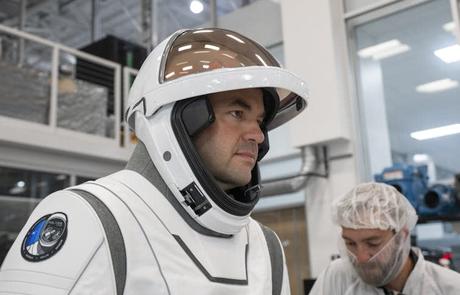SpaceX, CC BY-NC-ND" src="https://s.yimg.com/ny/api/res/1.2/UCeJyOXtMSID6htV5JcaoA-/YXBwaWQ9aGlnaGxhbmRlcjt3PTk2MDtoPTY0MQ-/https://media.zenfs.com/en/the_conversation_464/704c561452f1958ff dc146138522f9bb" data-src="https://s.yimg.com/ny/api/res/1.2/UCeJyOXtMSID6htV5JcaoA-/YXBwaWQ9aGlnaGxhbmRlcjt3PTk2MDtoPTY0MQ-/https://media.zenfs.com/en/the_conversation_464/704c561452f1958ffd c146138522f9bb"/>
The Polaris Dawn mission has attracted a lot of attention because it will be the first ever spacewalk by commercial space travelers. There are many reasons why this is a landmark mission. But with ambition comes a degree of risk.
The mission is backed by Elon Musk's SpaceX company and has no professional astronauts on board. The mission carries a businessman, a fighter pilot and two SpaceX employees. The mission represents an emerging parallel track in orbital spaceflight that is privately funded compared to the upcoming government-backed U.S. Artemis missions to return humans to the moon.
The four-member crew of Polaris Dawn is scheduled to launch on Wednesday, August 28, in a SpaceX Crew Dragon capsule from the Kennedy Space Center in Florida. During the five-day mission, they will travel farther from Earth than any human since the Apollo missions, reaching an altitude of 870 miles (1,400 km).
In addition to the spacewalk, the crew will travel through parts of the Van Allen radiation belts - zones of energetic charged particles around Earth. This will allow them to conduct tests aimed at understanding the effects of space radiation on human health.
Other experiments include an experiment on how the eyes and vision system respond in microgravity. The crew will also test a laser-based communications system in space. This will provide data for future space communications systems that could be used on missions to the Moon and Mars.
The spacecraft commander is Jared Isaacman, an American businessman who is flying for the second time on a commercial SpaceX mission. Retired U.S. Air Force Lieutenant Colonel Scott Poteet will serve as the mission pilot. Sarah Gillis is a mission specialist and is the chief engineer for space operations at SpaceX.
Gillis will perform the spacewalk, formally known as an extravehicular activity (EVA), alongside Isaacman. Finally, Anna Menon is a mission specialist and medical officer on the flight. Like Gillis, she is a SpaceX employee who leads space operations and is a mission director at the company.

The spacewalk will be slightly different from the kind we're used to on the International Space Station, where normally two astronauts go outside while the rest of the crew remains in the station's pressurized cabin.
The Dragon capsule has a hatch instead of an airlock. This means that the entire interior of the spacecraft must be depressurized and exposed to the vacuum of space when Isaacman and Gillis exit through the hatch to perform their 435-mile (700-km) spacewalk above Earth. All four crew members will therefore receive life support via spacesuits while the EVA is underway.
The crew will wear EVA suits designed by SpaceX, which are being used for the first time on this flight. They are significantly more streamlined than those worn by NASA astronauts aboard the ISS. The design of NASA's older suit, the Extravehicular Mobility Unit, has remained largely unchanged for more than 40 years.
Part of the bulk of NASA's suits, however, is that they have a life support system built into a backpack. By comparison, during the spacewalk, Isaacman and Gillis receive life support for their suits via long tubes called umbilicals that are attached to the capsule.
Ambitious goals
The significance of the Polaris Dawn EVA cannot be understated. Spacewalks have been reserved for government-sponsored space travelers since Alexei Leonov became the first human to leave a space capsule during the Soviet Voskhod 2 mission in 1965. The first spacewalk by an all-commercial crew is a key moment in the history of space exploration.
However, the ambitious goals of this mission also make it somewhat dangerous. Although all crew members are highly capable and well trained for this mission, there are no professional astronauts on board to provide advice. It is also the first space flight for three of the four crew members.
All that said, Polaris Dawn is an inspiring endeavor. These days, you often hear criticism of space travel along the lines of, "instead of going to space, why don't rich people give some of their money to needy people on Earth?"
During Inspiration4, Jared Isaacman's first space flight, aboard a Crew Dragon capsule, the businessman raised more than US$240 million (£181 million) for St Jude Children's Research Hospital in Memphis, Tennessee. He plans to repeat that success for this mission.
The Polaris Dawn website allows Internet users to donate to St Jude Children's Research Hospital, which aims to improve the detection and treatment of childhood cancers worldwide. The crew will also conduct several health-related experiments during the mission, with the goal of advancing medical research.
This is the first of three missions in a privately funded Polaris program. As more commercial missions take place, the cost of access to orbit will come down. This will help democratize space travel and open it up to people who aren't professional astronauts or the super-rich.
Hopefully it will also inspire the younger generation to see space not as a final frontier, but as a natural extension of humanity beyond the boundaries of Earth.
The mission will use the Dragon Resilience spacecraft, the vehicle that in 2020 conducted the first full mission to launch American astronauts from American soil, after NASA retired the space shuttle a decade earlier.
The connection between the achievements of the past and the astonishing results of the present is the most intriguing part of the story here. At least, that is how I see it as a child of the Apollo era, and apparently now, as a member of the Artemis generation.
This article is republished from The Conversation under a Creative Commons license. Read the original article.
Simonetta Di Pippo is not an employee of, an advisor to, an owner of shares in, or a recipient of funding from any company or organization that would benefit from this article. Furthermore, she has disclosed no relevant affiliations beyond her academic appointment.